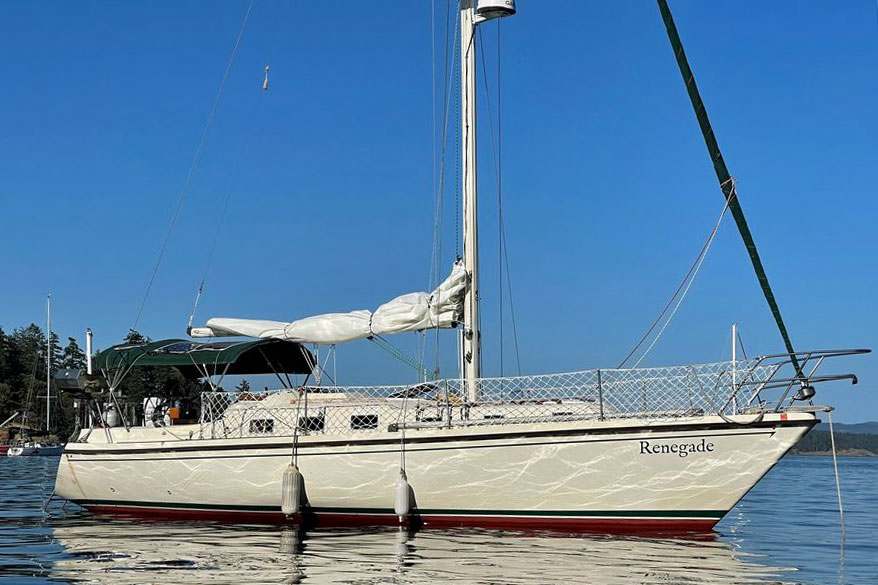- Home
- Cruising Yachts 30' to 35'
- Allmand 35
The Allmand 35 Sailboat
Specs & Key Performance Indicators
The Allmand 35, a heavy-displacement masthead sloop, was designed by Walter Scott and built in the USA by Allmand Boats.
 An Allmand 35
An Allmand 35Published Specification for the Allmand 35
Underwater Profile: Fin keel & skeg-hung rudder
Hull Material: GRP (Fibreglass)
Length Overall: 34'9" (10.6m)
Waterline Length: 28'2" (8.6m)
Beam: 11'8" (3.6m)
Draft: 5'2" (1.6m)
Rig Type: Masthead sloop
Displacement: 15,100lb (6,849kg)
Ballast: 4,300lb (1,950kg)
Designer: Walter Scott
Builder: Allmand Boats (USA)
Year First Built: 1981
Year Last Built: 1985
Published Design Ratios for the Allmand 35
1. Sail Area/Displacement Ratio: 14.4
- Less than 16 would be considered under-powered;
- 16 to 20 would indicate reasonably good performance;
- Over 20 suggests relatively high performance.
2. Ballast/Displacement Ratio: 28.5
- Under 40: less stiff, less powerful
- Over 40: stiffer, more powerful
3. Displacement/Length Ratio: 302
- Under 100: Ultralight
- 100 to 200: Light
- 200 to 275: Moderate
- 275 to 350: Heavy
- Over 350: Ultraheavy
4. Comfort Ratio: 29.4
- Under 20 indicates a lightweight racing boat
- 20 to 30 indicates a coastal cruiser
- 30 to 40 indicates a moderate offshore cruising boat
- 40 to 50 indicates a heavy offshore boat
- Over 50 indicates an extremely heavy offshore boat
5. Capsize Screening Formula: 1.9
- Under 2.0 (the lower the better): Better suited for ocean passages
- Over 2.0: Less suited for ocean passages
Read more about these Key Performance Indicators...
Summary Analysis of the Design Ratios for the Allmand 35
1. A Sail Area/Displacement Ratio of just 14.4 suggests that the Allmand 35 will need a stiff breeze to get her going. In light conditions, unless you've got plenty of time on your hands, motor-sailing may be the way to go.
2. A Ballast/Displacement Ratio of 28.5 means that a sailboat like the Allmand 35 (which doesn't have the benefit of a stiffness-enhancing bulb keel), is likely to benefit from being reefed early to keep her sailing upright in a moderate breeze.
3. A Displacement/Length Ratio of 302, tells us the Allmand 35 is clearly a heavy displacement cruising boat. You can load her down with all your cruising gear and equipment and it will hardly affect her waterline. Not an ideal choice for coastal sailing, but she'll come into her own on an offshore passage in testing conditions.
4. Ted Brewer's Comfort Ratio of 29.4 suggests that crew comfort of a Allmand 35 in a seaway is similar to what you would associate with the motion of a coastal cruiser with moderate stability, which is not the best of news for anyone prone to seasickness.
5. The Capsize Screening Formula (CSF) of 1.9 indicates that a Allmand 35 would be a safer choice of sailboat for an ocean passage than one with a CSF of more than 2.0.
Cruisers' Questions
What were the best-known creations of yacht designer Walter Scott?
What were the best-known creations of yacht designer Walter Scott?
Walter Scott was a yacht designer who worked for 30 years at Grumman Aerospace and then became the chief engineer at Irwin Yachts. He was involved with the design of many yachts from the Irwin line, such as the Irwin 10/4, the Allmand 35, and the Captiva 35. He also designed the Watkins 27, which went into production in 1977, and the Allmand 31, which appeared in 1979. He is known to have designed a number of other ‘one off’ boats. One of his most famous creations was the Ice Bear, a luxury motor yacht built by Feadship in 1988 for the late automotive entrepreneur Jim Moran.
What are the benefits of a masthead sloop whwn compared with a fractional sloop?
What are the benefits of a masthead sloop whwn compared with a fractional sloop?
A masthead sloop is a sailboat with a single mast and a single headsail that is attached to the top of the mast. A fractional sloop is a sailboat with a single mast and a single headsail that is attached to a point below the top of the mast.
According to some sources, some of the benefits of a masthead sloop are:
- It has a larger jib and a larger spinnaker than a fractional sloop, which can give it a speed advantage when sailing downwind.
- It is easier to tune and more secure than a fractional sloop, because it has a backstay that directly opposes the forestay and keeps the mast in column.
- It is more common on cruising sailboats and can be considered a more traditional way to rig a boat.
Some of the benefits of a fractional sloop are:
- It has a smaller jib and a larger mainsail than a masthead sloop, which can make it easier to manage and maneuver around a racecourse.
- It gives more control over the sail shape, because the forestay tension can affect the mast bend and the mainsail flatness.
- It is more popular among racing sailboats and high-performance boats, because it can adapt to different wind conditions and sail changes better than a masthead sloop.
Of course, these are generalizations and there are pros and cons to both types of rigs. The choice depends on your sailing preferences, plans and goals.
Recent Articles
-
Passoa 47 Sailboat Review: Comprehensive Specs & Performance Analysis
Jan 04, 26 04:57 AM
Discover the Passoa 47, a legendary aluminium blue water cruiser by Garcia. Explore technical specifications, design ratios, and why its lifting keel is a game-changer for offshore sailors. -
Sailboat Wheel Steering Maintenance & Inspection Checklist
Dec 30, 25 02:32 PM
Keep your vessel’s helm responsive and reliable with our expert maintenance checklist. Master cable tensioning and system inspections to avoid mid-passage failures. -
Modern Boat Electronics and the Latest Marine Instruments
Dec 20, 25 05:27 PM
Should sailboat instruments be linked to the latest boat electronics as a fully integrated system, or is it best to leave them as independent units?













